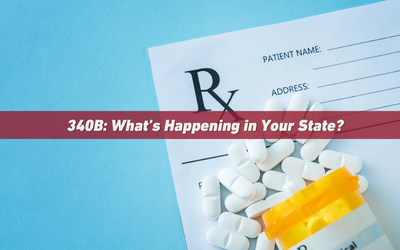
There are more than 60 340B bills working their way through state legislatures across the country– but what is the 340B program, and why should patients care?
The 340B Program allows certain hospitals and clinics to get discounts on prescription drugs, with the intent that these safety-net providers use those savings to provide better care for patients, especially those with low incomes. The problem is the program isn’t always working that way, and patients aren’t seeing the benefits.
A little context on 340B
- The 340B Program was established in 1992 as a federal drug discount program for safety net hospitals, Federally Qualified Health Centers (FQHCs) and certain specialized clinics, collectively referred to as covered entities.
- From 2010 to 2021, spending on prescription drugs through the program increased 19% annually.
- The increase in spending is partly attributed to 1) new federal guidance in 2010 allowing participating providers to work with a larger share of contract pharmacies, most of which are for-profit retail chains like CVS and Walgreens; and 2) the increase in eligible covered entities as a result of the Affordable Care Act to include children's hospitals, critical access hospitals, sole community hospitals and rural referral clinics.
- Though there is no mention of contract pharmacies in the original statute establishing the 340B program, between 2010 and 2021, the number of contract pharmacies grew from 2,100 to nearly 25,000.
- Increasing 340B pharmacies benefits pharmacy benefit managers (PBMs) not patients. More than 50 cents out of every dollar in profits contract pharmacies receive through the 340B program go to just four PBM and pharmacy companies.
- The growth of contract pharmacies attracted the attention of legislators and, around 2015, states began to shape how the 340B Program operates.
- In 2021, a court ruled that states have the authority to regulate how prescription drugs are delivered and dispensed within the state.
- In 2024, six states (Kansas, Maryland, Minnesota, Mississippi, Missouri and West Virginia) enacted bills to prohibit or limit manufacturers' ability to not extend 340B pricing to contract pharmacies.
- In 2025, 22 states are considering 340B legislation that would require extending discounted drug prices to 340B contracted pharmacies, prohibit certain contracting practices and require 340B covered entities to report their drug spending and savings.
What does this mean for chronic disease patients?
Covered entities are buying drugs at low prices but continuing to charge patients the higher price. Instead of putting the savings they receive back into the community for low income individuals, particularly those with chronic diseases, many hospitals use those savings to pad their profits or to subsidize unrelated services. This means chronic disease patients are forced to pay more for their medications and sometimes must make choices about how to spend their money on other necessities like rent, food, or school. While federal lawmakers may step in at some point to make changes to the program, right now, state legislatures are leading the charge.
What can chronic disease patients and families do?
Contact your elected leaders, especially if you live in one of the 22 states that are considering 340B legislation in 2025 (Connecticut, Colorado, Georgia, Indiana, Kentucky, Maine, Maryland, Massachusetts, Missouri, Mississippi, Montana, Nebraska, North Dakota, New Hampshire, New Mexico, New York, Oklahoma, Oregon, South Dakota, Utah, Virginia, Washington). Tell them to enforce existing 340B rules and find ways to improve transparency and reporting for 340B covered entities. Tell them the benefits of programs like 340B should be visible and accessible to patients. Let them know you don’t want to choose between paying for life’s necessities and paying for needed prescriptions.